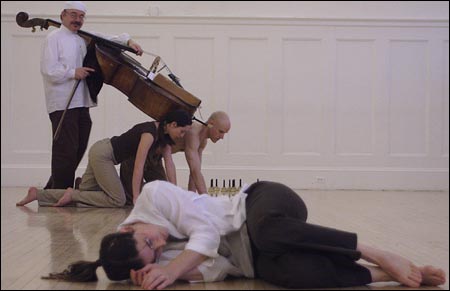Marjorie Morgan has extended her musical adventures with a new piece for seven dancers and double bassist. L’Anima, which she showed last weekend at Brookline Tai Chi, was a meditative blend of storytelling, movement, and natural sound. It counters the insistent hyperactivity that’s so common in dance performance today. You come away from it with settled nerves and some open space in your mind.

A SPARSE VOCABULARY — but plenty to think about. |
One by one the dancers entered the room on all fours, moving cautiously so as not to dislodge the handbells that were lined up on their spines; Jim Banta, the only male dancer, balanced one on the back of his shaved head. Nothing after that quite matched the weirdness of this image, but it established a climate of introspection and fantasy for what followed.
Three stories emerged, in song and complementary movement, about the relationship between wolfdom and humans. This bond, once realized, brought about mutual sustenance between species we usually think of as adversaries. Each story had a lesson about kindness and the wisdom of not judging your opponents too soon. Morgan’s texts didn't refer directly to the mess the world is in right now, but she probably wouldn’t mind if we made that leap.
When all the dancers had entered the space, they finally took the bells in their hands and stood up, ringing each one in turn. The bells were tuned to different pitches, and the dancers chimed a soft but resonant chorus as they whirled in big spirals through the space. Moving and vocalizing Italian phrases for pairs of contrasting sensations describing bells (“Che belle/Che amare” — “How beautiful/How bitter”), they wove an accompaniment around Morgan’s stories. In one especially effective sequence they created harmonic chants and walking patterns (“Che semplici” — “How simple”), and then a jumble of improvisatory polyphony (“Che complicate” — “How complicated”).
Morgan’s first story, “Song of the Wolf,” was about Romulus and Remus, the founders of Rome, who were brought up as foundlings by a she-wolf. As if Mother Goose, Morgan sang the tale with dramatic emphasis while the dancers gathered around her feet.
In “Il Lupo,” she played both the narrator and the main character, St. Francis, who helped a village to overcome its fear of a hungry wolf by teaching its citizens to leave food out every day. Jim Banta, the wolf, crept up to Morgan. She looked him in the eye and gained his trust. He laid his head on her feet.
With Janet Slifka as a speaking narrator in “Four Legs,” Morgan told of a childhood canine companion who somehow merged in memory with the rescuing she-wolf and the predator tamed by St. Francis. John Voigt, who’d been carried in with his double bass on the backs of two dancers, provided atmospheric thrums and rhythms to accompany this episode.
In spite of its relatively sparse vocabulary — the movement involved mostly crawling, falling, and walking variations; the singing was a series of vibratoless, chordal chants — L’Anima opened up a surprising number of associations and related themes. The idea of dependency, one species borne on the backs of another, was only one.
Morgan wrote all the texts and the music in addition to choreographing and performing the piece. The other imaginative dancers were Alison Ball, Ariella Amshalem, Jessica Newman, and Alli Ross. Although Morgan tells us that the title means “soul” in Italian, the anima also refers to the feminine principle in Jungian psychology. The individual is presumed to have both masculine and feminine tendencies, which, blending and interacting in different proportions, can produce a unified persona. I thought the stories and the thoughtful tone of the whole performance were an argument for compassion and a dampening of our aggressive side.
L’Anima was the first dance performance at Brookline Tai Chi. The high white space with its graceful archway and inner alcove provided a calm environment for Jayne Murphy’s nearly colorless washes of light and Morgan’s low-keyed ideas and evocations.